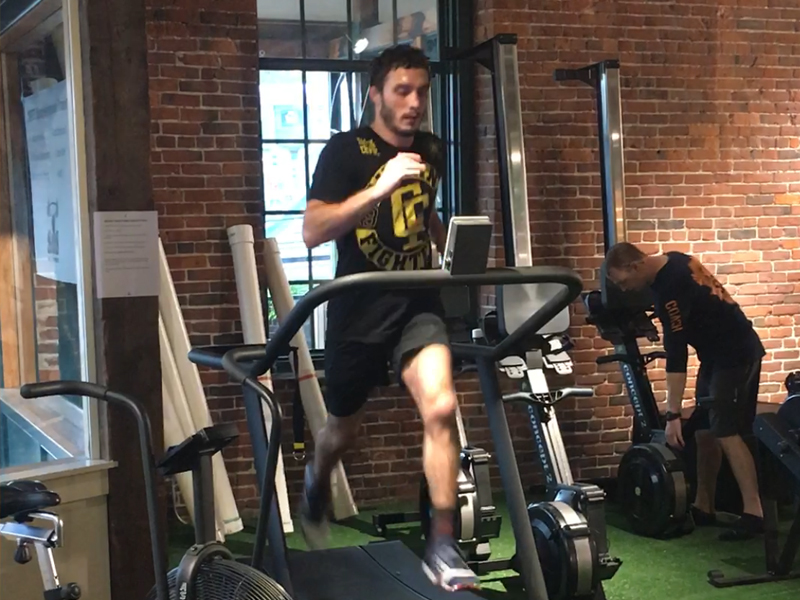As I often say, I’m happy with 80% of my programming and the remaining 20% is, and will always be, constantly evolving.
Today I’m going to share with you a handful of ways to improve your conditioning program.
1. Build the aerobic base
From a physiological standpoint, training the aerobic system will improve the following:
- number of mitochondria
- hemoglobin capacity
- aerobic enzymes
- glycogen storage
- blood stroke volume
In a perfect world, you want to develop the aerobic system before anything else. The beauty of training this system is that you can train this system daily and still make progress even if you’re in a fatigued state during a single session. In other words, aerobic work can almost always be performed at the end of a session without any negative consequences.
For field and court athletes or fighters, training the aerobic system 3 days a week for 60-90 minutes is perfect. I’d suggest changing up the activities to avoid any potential overtraining issues.
Here is a quick aerobic training template.
Day #1 – 60-90 minute run
Day #2 – 60-90 minute mountain bike ride
Day #3 – 60-90 minutes of cross training.
For example, a combination of rowing, cycling, versa climber, ski erg, jogging
A simple guideline for training the aerobic system is to keep your heart rate between 60- 75% of your max heart rate during these sessions. Also, pay attention to your breathing during aerobic work. If you find yourself mouth breathing, there’s a chance you are tapping into your anaerobic system and that’s not the goal. If you are able to breathe nasally during your aerobic work, it’s a good indicator that your heart rate is in the right zone.
The residual training effects of training the aerobic system shouldn’t be overlooked. Once developed, athletes can maintain aerobic adaptations for a number of weeks whereas anaerobic adaptations are usually maintained anywhere from 5 to 15 days. If you can maintain aerobic qualities upwards of 30 days without a serious detraining effect, this is the most logical place to start.
Aerobic training is just a really good training investment.

2. Use metrics
Science gives us guidelines and templates on how to develop each system appropriately, but I rarely see people using metrics. If you tell your client to work hard for X and rest for X you are missing valuable data that could be collected very easily.
Let’s assume you’ve gotten an athlete strong, developed his aerobic power and endurance and now you are emphasizing speed development.
Here are just a few of the benefits of maximum speed training:
- improved neuromuscular interaction
- improved motor control
- increased phosphocreatine storage
Here are guidelines suggested by Fox & Mathews, 1981.
To develop maximum speed, our work interval needs to be between :7 and :15 at maximal intensity. The suggested rest period should be 1:10. For example, a :7 sprint would be followed by a :70 rest period.
How do you know if you are hitting maximal speed if you never assessed it?
Here is a simple test you can use on an assault bike.
- Ride for a few minutes to get warm
- Slowly increase speed to a rolling start so you can work at max effort for :7. Record top speed and max power output “watts”
Use the recorded numbers as guidelines/target numbers to aim for when training maximum speed/power. Decide training load based off of the athletes, needs, training age and overall athletic development.

Listen, if you want to train for speed or power, you need to assess first. If you do not have guidelines and target numbers to hit, you are missing the boat! Assess, don’t guess.
3. Don’t confuse efficiency with conditioning
Refining your technique in any sport is vital, but it can also give you a false sense of being well-conditioned. If you are so efficient at a specific technique or exercise that you can train for days without getting tired, you can no longer depend on that specific training to provide a conditioning effect.
Let’s look at BJJ. Most black belts can roll for days. If a black belt trains with lower belt, they can still get work in, but will mostly likely need to train with guys that are of similar skill, strength, and conditioning levels in order to get a conditioning effect.
Simply put, you need to be pushed. Without appropriate stress, there is no adaptation and no conditioning effect.
Here’s something I’ve learned training BJJ 2-3 times a week times over the last 15 months. If you are VERY inefficient at something, there is a huge conditioning effect. You expend a ton of energy just trying to survive and that smokes you. This was enough conditioning for me when I started and honestly, I couldn’t have done more.
Now, I’m slowly getting better at BJJ and I can roll more. Did my cardio get better? Maybe a tiny bit, but the key is that I’m slowly becoming more efficient on the mat. If I want to continue to see progress, I still need to develop my technique on the mats and slowly fill the gaps with additional strength and conditioning.
As your technique and efficiency improves, you need to plan your strength and conditioning accordingly to continue to make progress.
Remember, its all about stress and adaptation!
If you choose dive into the world of energy systems, I’ll be honest. It’s a slippery slope and there are a ton of variables to consider.
Get Strong. Build the aerobic base. Assess your athletes. Use a heart rate monitor. Record everything. Never stop learning.
As always, train smart and train hard!


Great post. Very good information Here!